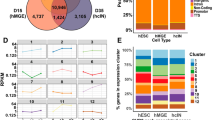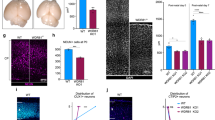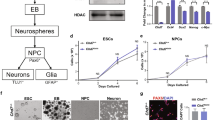Abstract
Charged multivesicular body protein 1A (CHMP1A; also known as chromatin-modifying protein 1A) is a member of the ESCRT-III (endosomal sorting complex required for transport-III) complex1,2 but is also suggested to localize to the nuclear matrix and regulate chromatin structure3. Here, we show that loss-of-function mutations in human CHMP1A cause reduced cerebellar size (pontocerebellar hypoplasia) and reduced cerebral cortical size (microcephaly). CHMP1A-mutant cells show impaired proliferation, with increased expression of INK4A, a negative regulator of stem cell proliferation. Chromatin immunoprecipitation suggests loss of the normal INK4A repression by BMI in these cells. Morpholino-based knockdown of zebrafish chmp1a resulted in brain defects resembling those seen after bmi1a and bmi1b knockdown, which were partially rescued by INK4A ortholog knockdown, further supporting links between CHMP1A and BMI1-mediated regulation of INK4A. Our results suggest that CHMP1A serves as a critical link between cytoplasmic signals and BMI1-mediated chromatin modifications that regulate proliferation of central nervous system progenitor cells.
This is a preview of subscription content, access via your institution
Access options
Subscribe to this journal
Receive 12 print issues and online access
$209.00 per year
only $17.42 per issue
Buy this article
- Purchase on Springer Link
- Instant access to full article PDF
Prices may be subject to local taxes which are calculated during checkout




Similar content being viewed by others
Accession codes
Accessions
NCBI Reference Sequence
References
Howard, T.L., Stauffer, D.R., Degnin, C.R. & Hollenberg, S.M. CHMP1 functions as a member of a newly defined family of vesicle trafficking proteins. J. Cell Sci. 114, 2395–2404 (2001).
Tsang, H.T. et al. A systematic analysis of human CHMP protein interactions: additional MIT domain–containing proteins bind to multiple components of the human ESCRT III complex. Genomics 88, 333–346 (2006).
Stauffer, D.R., Howard, T.L., Nyun, T. & Hollenberg, S.M. CHMP1 is a novel nuclear matrix protein affecting chromatin structure and cell-cycle progression. J. Cell Sci. 114, 2383–2393 (2001).
1000 Genomes Project Consortium. A map of human genome variation from population-scale sequencing. Nature 467, 1061–1073 (2010).
Stuchell-Brereton, M.D. et al. ESCRT-III recognition by VPS4 ATPases. Nature 449, 740–744 (2007).
Scita, G. & Di Fiore, P.P. The endocytic matrix. Nature 463, 464–473 (2010).
Molofsky, A.V. et al. Bmi-1 dependence distinguishes neural stem cell self-renewal from progenitor proliferation. Nature 425, 962–967 (2003).
Garel, C., Fallet-Bianco, C. & Guibaud, L. The fetal cerebellum: development and common malformations. J. Child Neurol. 26, 1483–1492 (2011).
Jacobs, J.J., Kieboom, K., Marino, S., DePinho, R.A. & van Lohuizen, M. The oncogene and Polycomb-group gene bmi-1 regulates cell proliferation and senescence through the ink4a locus. Nature 397, 164–168 (1999).
Leung, C. et al. Bmi1 is essential for cerebellar development and is overexpressed in human medulloblastomas. Nature 428, 337–341 (2004).
van der Lugt, N.M. et al. Posterior transformation, neurological abnormalities, and severe hematopoietic defects in mice with a targeted deletion of the bmi-1 proto-oncogene. Genes Dev. 8, 757–769 (1994).
Zencak, D. et al. Bmi1 loss produces an increase in astroglial cells and a decrease in neural stem cell population and proliferation. J. Neurosci. 25, 5774–5783 (2005).
Kent, W.J. et al. The human genome browser at UCSC. Genome Res. 12, 996–1006 (2002).
Gudbjartsson, D.F., Jonasson, K., Frigge, M.L. & Kong, A. Allegro, a new computer program for multipoint linkage analysis. Nat. Genet. 25, 12–13 (2000).
Rozen, S. & Skaletsky, H.J. Primer3 on the WWW for general users and for biologist programmers. in Bioinformatics Methods and Protocols: Methods in Molecular Biology (eds. Krawetz, S. & Misener, S.) 365–386 (Humana Press, Totowa, New Jersey, 2000).
Brunak, S., Engelbrecht, J. & Knudsen, S. Prediction of human mRNA donor and acceptor sites from the DNA sequence. J. Mol. Biol. 220, 49–65 (1991).
Flavell, S.W. et al. Genome-wide analysis of MEF2 transcriptional program reveals synaptic target genes and neuronal activity–dependent polyadenylation site selection. Neuron 60, 1022–1038 (2008).
Kimmel, C.B., Ballard, W.W., Kimmel, S.R., Ullmann, B. & Schilling, T.F. Stages of embryonic development of the zebrafish. Dev. Dyn. 203, 253–310 (1995).
Link, V., Shevchenko, A. & Heisenberg, C.P. Proteomics of early zebrafish embryos. BMC Dev. Biol. 6, 1 (2006).
Bilimoria, P.M. & Bonni, A. Cultures of cerebellar granule neurons. CSH Protoc. 2008, pdb prot5107 (2008).
Acknowledgements
We thank the individuals and their families reported herein for their participation in this research. We thank M. van Lohuizen (Netherlands Cancer Institute) for providing the Bmi1-knockout mice, A. Wagers for help with breeding the Bmi1-knockout mice and P. Baas for sharing human DNA samples. This research was supported by grants from the US National Institute of Neurological Disorders and Stroke (NINDS; R01NS035129) and the Fogarty International Center (R21TW008223) to C.A.W., the Dubai Harvard Foundation for Medical Research, the Simons Foundation and the Manton Center for Orphan Disease Research. G.H.M. was supported by the Young Investigator Award of the National Alliance for Research on Schizophrenia and Depression (NARSAD) as a NARSAD Lieber Investigator. V.S.G. is supported by the Medical Scientist Training Program of Harvard Medical School, with financial support from the US National institute of General Medical Sciences (NIGMS). C.A.W. and L.I.Z. are investigators of the Howard Hughes Medical Institute. Microscopy and image analyses were performed with support from the Cellular Imaging Core of the Boston Children's Hospital Intellectual and Developmental Disabilities Research Center.
Author information
Authors and Affiliations
Contributions
G.H.M. designed the study, interpreted clinical information and brain MRIs, identified the disease locus, helped sequence candidate genes, analyzed the sequencing data to identify CHMP1A mutations, helped analyze the functional data and wrote the manuscript. V.S.G. performed RT-PCR, protein blots, mouse histology and immunohistochemistry, qPCR, ChIP and zebrafish morpholino experiments and wrote the manuscript. M.I.d.M. and H.D. ascertained family 1 and provided clinical information. K.D.A. performed zebrafish protein blots and mouse immunohistochemistry. K.L.K. performed the morpholino injections. H.-T.H. and L.I.Z. assisted with the morpholino experiments. R.S.H. helped organize genetic data and calculate LOD scores. J.M.F. and D.G. organized human samples and helped perform sequencing experiments. D.R. organized human samples and helped perform microsatellite analysis. A.D.H. assisted in immunohistochemical studies and imaging. A.N.M. assisted in ChIP. B.J.B. and J.N.P. organized clinical information and human samples. W.-H.T. and L.J.G. provided clinical information for family 3. A.J.B. interpreted the brain MRIs of the affected individuals. W.B.D. ascertained family 2 and provided clinical information. C.A.W. directed the overall research and wrote the manuscript.
Corresponding author
Ethics declarations
Competing interests
L.I.Z. is a founder and stockholder of Fate Therapeutics, Inc., and a scientific advisor for Stemgent.
Supplementary information
Supplementary Text and Figures
Supplementary Figures 1–6, Supplementary Table 1 and Supplementary Note (PDF 4341 kb)
Supplementary Video 1
Brain MRI of CH2402. T1-weighted sagittal sequence reveals a very small cerebellum (vermis and hemispheres) and pons. There is no malformation of the cerebral cortex but the cerebral white matter volume is severely reduced with a fully formed but thin corpus callosum. (MOV 907 kb)
Supplementary Video 2
Brain MRI of CH3102. T1-weighted saggital sequence shows a very small cerebellum (vermis and hemispheres), and pons. There is no malformation of the cerebral cortex but the cerebral white matter is moderately diminished in volume with a fully formed but thin corpus callosum. (MOV 1752 kb)
Rights and permissions
About this article
Cite this article
Mochida, G., Ganesh, V., de Michelena, M. et al. CHMP1A encodes an essential regulator of BMI1-INK4A in cerebellar development. Nat Genet 44, 1260–1264 (2012). https://doi.org/10.1038/ng.2425
Received:
Accepted:
Published:
Issue Date:
DOI: https://doi.org/10.1038/ng.2425
This article is cited by
-
Broadening the phenotype and genotype spectrum of novel mutations in pontocerebellar hypoplasia with a comprehensive molecular literature review
BMC Medical Genomics (2024)
-
A novel homozygous CHMP1A variant arising from segmental uniparental disomy causes pontocerebellar hypoplasia type 8
Journal of Human Genetics (2023)
-
The emerging mechanisms and functions of microautophagy
Nature Reviews Molecular Cell Biology (2023)
-
Recent advances in novel mutation genes of Parkinson's disease
Journal of Neurology (2023)
-
Classic “PCH” Genes are a Rare Cause of Radiologic Pontocerebellar Hypoplasia
The Cerebellum (2023)



